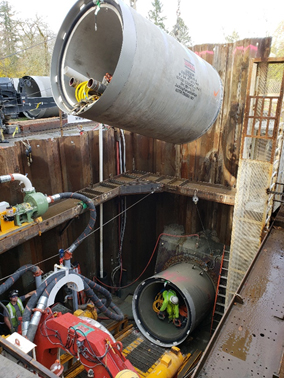The Contractor's Song: Builder As Advisor — Solid (As A Rock)
By Jeremy Holland

And soon both of us learned to trust / Not run away, it was no time to play / We build it up and build it up and build it up / And now it's solid / Solid as a rock
-Ashford & Simpson
Over the first 25 years of my career, I spent a great deal of that time working as the engineer and advising owners from the engineering perspective. While I was involved in alternative delivery projects as an engineer, it wasn’t until I joined Mortenson and focused on building water infrastructure projects for owners through alternative delivery projects that I came to appreciate the role of the contractor. I’ve come to realize, and I think more and more owners are realizing this as well, that a contractor is very well-suited to perform the role of an overall project advisor. I’ve discussed in past articles the challenge of supply chain disruptions, cost volatility, technical construction challenges, and start-up and commissioning. As I’ve jumped into these and other issues, I’ve been enlightened that projects led by a contractor can provide some “solid” benefits to owners that are looking to have a single point of guidance as they deliver water infrastructure for their communities.
Master Builder Builds It Up
Backing up from where project delivery is today, it is worth looking at how owners historically constructed their projects. This is where the concept of the master builder comes from. For many years in the past (literally thousands of them), a master builder was a person who developed the entire project for an owner. They were responsible for the planning, the design, and the construction. Over time, as the profession of engineering and architectural design became more specialized, there became a feeling that this professional work needed to be differentiated from the labor necessary to construct the work. This separation of design and construction became codified in the 1930s through the Miler Act. Owners have largely managed separate contracts for design and construction ever since.
Tried To Separate Us
Somehow, along the way we lost the benefit of the master builder and determined that risk was better managed by separating the builder from the designer. As Ashford & Simpson said, “Gone with the wind, another friend, got in between, tried to separate us” which is one of the big negatives of design-bid-build. The designer and builder are managed under separate contracts by the owner. With two separate contracts, there is no interaction between the two parties until the design is completed and bid. And then the construction phase can become an exercise of finger-pointing when things don’t go right. And, really, the issue with this approach is not that there is built in conflict from the outset but that there are missed opportunities to collaborate if the designer and builder are working together earlier on.
We Had To Stick Together
Getting back to how projects used to be delivered has been a slow process that has met with a varying degree of approval depending on where you work. Various locations around the U.S. and the world at large have developed different approaches to builder to participation in the design phase. The two most collaborative approaches are Construction Manager at Risk (CMAR) (also known as CM/GC or GC/CM, depending on where you are) and Progressive Design-Build. With CMAR projects the owner still holds two separate contracts, one with the design and one with the builder; however, the builder is hired some time before the design is completed and participates in the design phase to add constructability, construction sequencing, and cost analysis. This is can work well when the relationships can be built between two parties that have been brought together by the owner. Progressive Design-Build provides the added benefit of a single contract and therefore single point of responsibility. For the owner, this is really full circle back to the master builder approach and relying on the specific skills a builder brings to the table to advise and direct the overall project.
Willing To Take A Chance

Coda — Let’s Build It Up And Build It Up And Build It Up
So, the call to action in this month’s article is for you, the owner, to spend some time thinking through how you want a project to be delivered. Think about the benefits of starting with the builder and assembling the team you need to complete the project. The builder has the physical and mental tools to successfully navigate all the steps of taking a project from a concept to completion. We understand what is needed to bring a project to life and how that construction activity translates into design decisions. We are acutely attuned to cost and schedule and can support an owner’s needs to maintain both. Let’s get out there and build it up, solid as a rock, together!
 Jeremy Holland is a Market Executive in the Water Infrastructure Market in Mortenson Seattle’s Operating Group. With 23 years of engineering experience, Jeremy has served as project principal, technical advisor, project manager, and design engineer. His industry knowledge spans a wide variety of projects, clients, disciplines, and engineering problems. A licensed Professional Engineer in Oregon, WA, and Puerto Rico, Jeremy received a Bachelor of Science in Chemical Engineering and a Bachelor of Arts in English from the University of Notre Dame, and a master’s degree in Business Administration from Portland State University. He is a board member of the Oregon Association of Clean Water Agencies and is the Co-Chair of the Water Quality Committee.
Jeremy Holland is a Market Executive in the Water Infrastructure Market in Mortenson Seattle’s Operating Group. With 23 years of engineering experience, Jeremy has served as project principal, technical advisor, project manager, and design engineer. His industry knowledge spans a wide variety of projects, clients, disciplines, and engineering problems. A licensed Professional Engineer in Oregon, WA, and Puerto Rico, Jeremy received a Bachelor of Science in Chemical Engineering and a Bachelor of Arts in English from the University of Notre Dame, and a master’s degree in Business Administration from Portland State University. He is a board member of the Oregon Association of Clean Water Agencies and is the Co-Chair of the Water Quality Committee.
